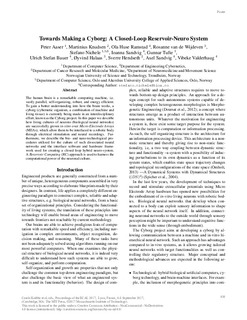| dc.contributor.author | Aaser, Peter | |
| dc.contributor.author | Knudsen, Martinius | |
| dc.contributor.author | Huse Ramstad, Ola | |
| dc.contributor.author | van de Wijdeven, Rosanne | |
| dc.contributor.author | Nichele, Stefano | |
| dc.contributor.author | Sandvig, Ioanna | |
| dc.contributor.author | Tufte, Gunnar | |
| dc.contributor.author | Bauer, Ulrich Stefan | |
| dc.contributor.author | Halaas, Øyvind | |
| dc.contributor.author | Hendseth, Sverre | |
| dc.contributor.author | Sandvig, Axel | |
| dc.contributor.author | Valderhaug, Vibeke Devold | |
| dc.date.accessioned | 2018-01-24T08:14:15Z | |
| dc.date.available | 2018-01-24T08:14:15Z | |
| dc.date.created | 2017-09-14T16:32:54Z | |
| dc.date.issued | 2017 | |
| dc.identifier.isbn | 978-0-262-34633-7 | |
| dc.identifier.uri | http://hdl.handle.net/11250/2479230 | |
| dc.description.abstract | The human brain is a remarkable computing machine, i.e. vastly parallel, self-organizing, robust, and energy efficient. To gain a better understanding into how the brain works, a cyborg (cybernetic organism, a combination of machine and living tissue) is currently being made in an interdisciplinary effort, known as the Cyborg project. In this paper we describe how living cultures of neurons (biological neural networks) are successfully grown in-vitro over Micro-Electrode Arrays (MEAs), which allow them to be interfaced to a robotic body through electrical stimulation and neural recordings. Furthermore, we describe the bio- and nano-technological procedures utilized for the culture of such dissociated neural networks and the interface software and hardware framework used for creating a closed-loop hybrid neuro-system. A Reservoir Computing (RC) approach is used to harness the computational power of the neuronal culture. | nb_NO |
| dc.language.iso | eng | nb_NO |
| dc.publisher | MIT Press | nb_NO |
| dc.relation.ispartof | Proceedings of the European Conference on Artificial Life 2017 | |
| dc.relation.uri | https://www.ntnu.edu/socrates | |
| dc.rights | Navngivelse 4.0 Internasjonal | * |
| dc.rights.uri | http://creativecommons.org/licenses/by/4.0/deed.no | * |
| dc.title | Towards Making a Cyborg: A Closed-Loop Reservoir-Neuro System | nb_NO |
| dc.type | Chapter | nb_NO |
| dc.type | Peer reviewed | nb_NO |
| dc.description.version | publishedVersion | nb_NO |
| dc.source.pagenumber | 430-437 | nb_NO |
| dc.identifier.doi | 10.7551/ecal_a_072 | |
| dc.identifier.cristin | 1493907 | |
| dc.relation.project | Norges forskningsråd: 270961 | nb_NO |
| dc.description.localcode | © 2017 Massachusetts Institute of Technology Published under a Creative Commons Attribution 4.0 International (CC BY 4.0) license | nb_NO |
| cristin.unitcode | 194,63,10,0 | |
| cristin.unitcode | 194,63,25,0 | |
| cristin.unitcode | 194,65,30,0 | |
| cristin.unitcode | 194,63,35,0 | |
| cristin.unitcode | 194,65,15,0 | |
| cristin.unitname | Institutt for datateknologi og informatikk | |
| cristin.unitname | Institutt for teknisk kybernetikk | |
| cristin.unitname | Institutt for nevromedisin og bevegelsesvitenskap | |
| cristin.unitname | Institutt for elektroniske systemer | |
| cristin.unitname | Institutt for klinisk og molekylær medisin | |
| cristin.ispublished | true | |
| cristin.fulltext | postprint | |
| cristin.fulltext | original | |
| cristin.qualitycode | 2 | |

